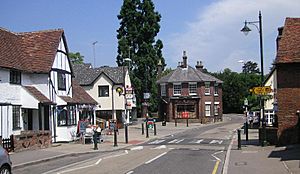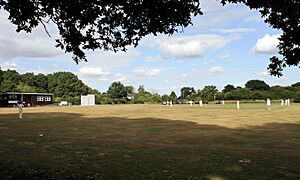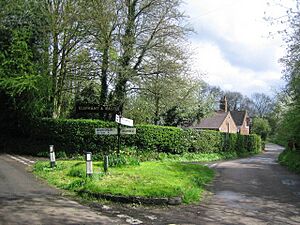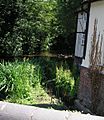Wheathampstead facts for kids
Quick facts for kids Wheathampstead |
|
|---|---|
 Wheathampstead village centre |
|
| Area | 10.03 sq mi (26.0 km2) |
| Population | 6,622 (2021) |
| • Density | 660/sq mi (250/km2) |
| OS grid reference | TL1714 |
| Civil parish |
|
| District | |
| Shire county | |
| Region | |
| Country | England |
| Sovereign state | United Kingdom |
| Post town | St Albans |
| Postcode district | AL4 |
| Dialling code | 01582 |
| Police | Hertfordshire |
| Fire | Hertfordshire |
| Ambulance | East of England |
| EU Parliament | East of England |
| UK Parliament |
|
| Website | Wheathampstead Parish Council |
Wheathampstead is a lovely village and a local area (called a civil parish) in Hertfordshire, England. It is located north of the city of St Albans. In 2021, about 6,622 people lived in the area (called a ward). A small group of houses known as Amwell is also part of the Wheathampstead parish.
Contents
History of Wheathampstead
Ancient Times and Early Settlements
Around 50 BC, people called the Belgae settled in this area. They came from what is now Belgium, traveling along the Thames and Lea rivers. Signs of their presence have been found at a place called Devil's Dyke, on the eastern side of Wheathampstead.
The Devil's Dyke is a large earthwork. It is part of an old settlement built by the Catuvellauni tribe. Many people believe this was their first capital city. Around 20 BC, the capital moved to Verlamion. After the Romans arrived, they renamed it Verulamium. This place eventually became the modern city of St Albans.
Some historians think that the Roman leader Julius Caesar defeated Cassivellaunus at Devil's Dyke in 54 BC. However, this idea is still debated. Some experts suggest that Devil's Dyke was connected to another defensive wall, Beech Bottom Dyke. If this is true, it would mean the area was one of the biggest and most important British Iron Age settlements.
Wheathampstead in the Middle Ages
The village of Wheathampstead is mentioned in the Domesday Book of 1086. This was a very old survey of land in England. At that time, the village was called Watamestede. It seems there was a church in Wheathampstead even before the Norman Conquest in 1066. King Edward the Confessor gave Wheathampstead to Westminster Abbey.
It is hard to tell if any part of the current St Helen's Church is from Saxon times. The original church was taken down when King Henry III was in charge. The oldest part of the church we see today, in the chancel, was built around 1280.
Important People from the Past
Many important people have been connected to Wheathampstead over the centuries. Some rectors (church leaders) of Wheathampstead-cum-Harpenden went on to have very successful careers. For example, Richard Sampson was a rector in the 1500s. He later became a bishop. Another rector, Richard Pate, also became a bishop.
Henry Killigrew became the Master of the Savoy in 1661. John Lambe, whose father helped prisoners, was also a rector. He became a special chaplain to King William III and Queen Mary II. Even Queen Victoria's private teacher was once a rector here.
The village is also close to Nomansland Common. The city of St Albans is not far away either.
Amwell Hamlet
Amwell is a small group of houses, called a hamlet. It is about one mile southwest of Wheathampstead. Amwell is part of the same local and church area as Wheathampstead. This small settlement is very old, first mentioned in records from 1272. Its name comes from old English words meaning "an enclosure" and "a spring."
Amwell has five buildings that are officially protected because of their history. Four of these are old cottages from the 1700s. The fifth is the Elephant and Castle pub, which might have parts of its chimneys from the 1500s! Amwell became a special "conservation area" in 1983. This means its historic character is protected.
Transport in Wheathampstead
Wheathampstead once had its own railway station. However, it closed in 1965. You can even find an old film of the train line on its last day on YouTube.
Today, public transport is provided by buses. One bus runs every hour between Borehamwood and Harpenden. Another bus, run by Uno, goes through Wheathampstead every half hour. This bus travels between Luton and Hatfield.
Notable Residents
Many interesting people have lived in Wheathampstead:
- Rudolph Lambart, 10th Earl of Cavan (1865–1946) was a Field Marshal, a very high-ranking army officer.
- Apsley Cherry-Garrard (1886–1959) was a famous polar explorer.
- Reginald Owen (1887–1972) was a well-known character actor in movies.
- William Beach Thomas (1868–1957) was an author and journalist who wrote about country life. He lived and is buried here.
- Archie Camden (1888–1979) was a talented bassoon player.
- Michael Ventris (1922-1956) was a linguist who figured out an ancient writing system called Linear B.
- Nick Halling is a TV presenter and sports journalist.
- Nick Payne is a playwright, someone who writes plays.
Images for kids
See also
 In Spanish: Wheathampstead para niños
In Spanish: Wheathampstead para niños







